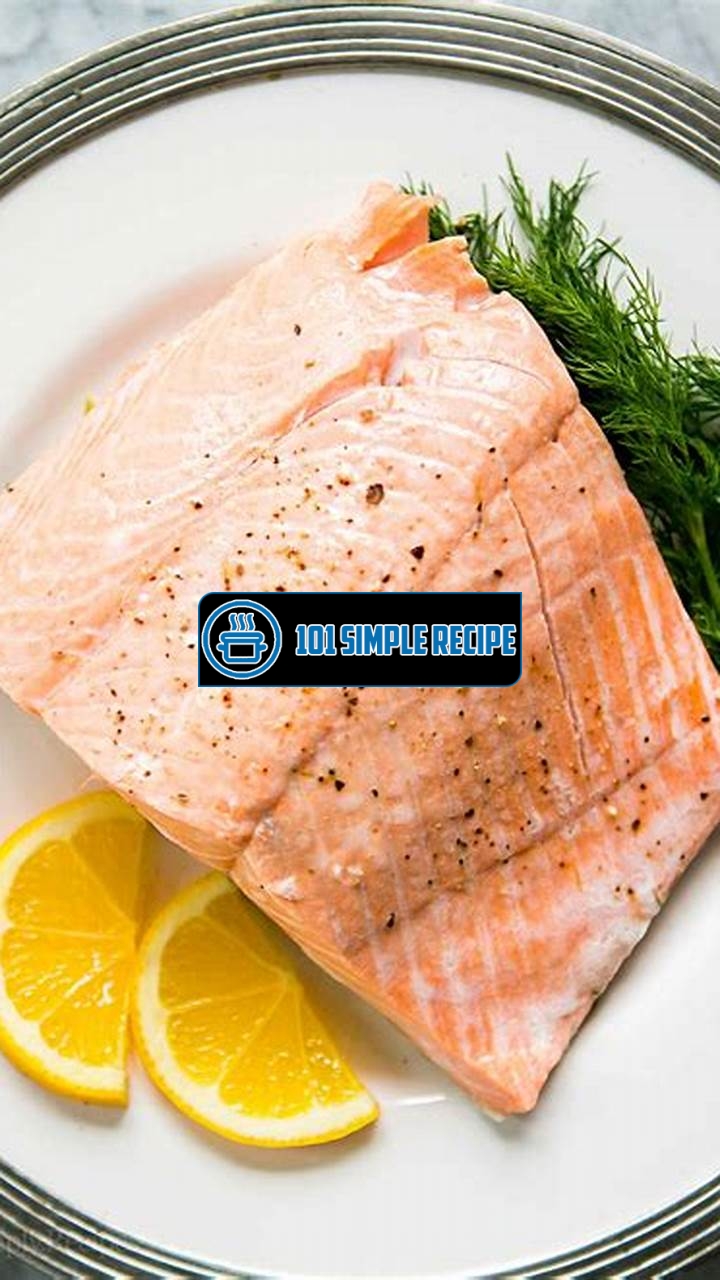If you’re craving a gourmet seafood dish that’s both healthy and delicious, look no further than poached salmon. This cooking method is renowned for its ability to produce tender, moist fish with a delicate flavor. Whether you’re hosting a dinner party or simply treating yourself to a special meal, knowing how to make the perfect poached salmon is a valuable culinary skill. In this article, we’ll guide you through the step-by-step process, sharing expert tips and techniques to help you achieve restaurant-quality results in your own kitchen. So grab your apron, sharpen your chef’s knife, and let’s dive into the wonderful world of poached salmon. ️

The Benefits of Poaching Salmon
Discover why poaching is a popular cooking method for salmon and how it enhances the flavor and texture of the fish.
Why Poaching?
Poaching salmon is a method that involves gently cooking the fish in liquid at a low temperature. This cooking technique is beneficial for several reasons. Firstly, it allows the salmon to retain its moisture, resulting in a tender and juicy texture. Secondly, poaching allows the flavors of the fish to blend seamlessly with the liquid, creating a delicious and flavorful dish. The gentle heat of poaching also helps to preserve the delicate taste of the salmon, preventing it from becoming overpowering or dry.
- ✅ Retains moisture
- ✅ Blends flavors
- ✅ Preserves delicate taste
Advantages of Poaching Salmon
Poaching salmon offers several advantages over other cooking methods. One of the main benefits is that it is a healthier option compared to frying or grilling. When you poach salmon, you do not need to use oil or butter, making it a low-fat cooking method. Additionally, the gentle cooking process of poaching helps to preserve the omega-3 fatty acids found in salmon, which have numerous health benefits, including reducing inflammation and improving heart health.
Another advantage of poaching salmon is that it is a forgiving cooking technique. Unlike grilling or pan-searing, there is less risk of overcooking the fish when you poach it. The precise control over the cooking temperature ensures that the salmon remains perfectly cooked and tender. This makes poaching a great option for those who are new to cooking salmon or are worried about overcooking it.
- ✅ Healthier option
- ✅ Preserves omega-3 fatty acids
- ✅ Forgiving cooking technique
Choosing the Right Salmon for Poaching
When it comes to poaching salmon, choosing the right type of salmon is essential to achieve the best results. Fresh, high-quality salmon works best for poaching. Look for salmon fillets that are firm and have a vibrant color. Avoid salmon that has a strong fishy smell or looks dull in color.
There are different types of salmon available, including Atlantic, Chinook, Sockeye, and Coho salmon. While all of these varieties can be poached, some may have a stronger flavor than others. If you prefer a milder taste, opt for Atlantic or Chinook salmon. If you enjoy a more robust flavor, Sockeye or Coho salmon may be the better choice.
Additionally, consider the sustainability of the salmon you choose. Look for salmon that is labeled as sustainably sourced to ensure that you are making an environmentally friendly choice.
- ✅ Choose fresh, high-quality salmon
- ✅ Look for vibrant color
- ✅ Consider flavor preferences
- ✅ Opt for sustainably sourced salmon
Essential Tools and Ingredients
Welcome to this guide on how to make the perfect poached salmon. In order to achieve poached salmon perfection, it’s important to have the right tools and ingredients at your disposal. By following the tips and techniques outlined in this article, you’ll be well on your way to creating a delicious and succulent poached salmon dish.
Key Tools for Poaching Salmon
To successfully poach salmon, you’ll need a few key tools to ensure the process goes smoothly. Here are the essential tools you’ll need:
- Large Saucepan: A large saucepan or deep skillet is necessary to accommodate the size of the salmon fillets. Make sure the pan is large enough to hold the salmon comfortably.
- Slotted Spoon: A slotted spoon is crucial for transferring the poached salmon from the liquid to a serving dish. This allows the excess liquid to drain away without taking the salmon with it.
- Thermometer: To ensure the salmon is cooked to perfection, it’s important to monitor the temperature. Use a food thermometer to check the internal temperature of the salmon. The ideal temperature is between 120-130°F (49-54°C).
- Tongs: Tongs are useful for handling the salmon fillets as they can be delicate and prone to breaking apart. Use tongs to carefully flip the salmon fillets while poaching.
- Lid: A lid for the saucepan is necessary to trap the heat and steam, creating the ideal cooking environment for the salmon. Make sure the lid fits securely on the pan to prevent steam from escaping.
Ingredients for a Poached Salmon Recipe
Now let’s explore the essential ingredients needed for a delicious poached salmon:
- Salmon Fillets: Choose fresh salmon fillets for the best results. Look for fillets that have a vibrant pink color and firm texture.
- Liquid: The liquid used for poaching can vary depending on personal preference. Common options include water, fish stock, vegetable broth, or white wine. The liquid should be flavorful to enhance the taste of the salmon.
- Aromatics: Aromatics such as herbs, spices, and vegetables can be added to the poaching liquid to infuse the salmon with extra flavor. Popular choices include dill, parsley, garlic, onion, and lemon slices.
- Salt and Pepper: Season the poaching liquid with salt and pepper to enhance the flavor of the salmon.
Tips for Selecting Fresh Salmon
When selecting fresh salmon for your poached salmon recipe, keep these tips in mind:
- Appearance: Look for salmon fillets that have a vibrant pink color. Avoid fillets with dull or discolored flesh.
- Firmness: Gently press the salmon fillets to check for firmness. The flesh should spring back when touched.
- Smell: Fresh salmon should have a mild, seaweed-like smell. Avoid fishy or pungent odors.
- Origin: Choose salmon that is sourced from reputable suppliers or sustainable fishing practices. This ensures the best quality and supports responsible fishing.
By following these tips and utilizing the essential tools and ingredients mentioned above, you’ll be equipped to make the perfect poached salmon. Enjoy the process and savor the delicious results!
Whole Foods Chantilly Cake recipe will take your dessert game to a whole new level. Impress your friends and family with this decadent and delicious cake.
Mastering the Poaching Technique
Learning how to poach salmon is an essential skill that every seafood lover should master. While there are many cooking methods available, poaching is a delicate technique that ensures you achieve perfectly cooked and flavorful fish every time. Whether you’re a seasoned chef or a home cook, mastering the poaching technique will elevate your culinary skills to the next level.
Preparing the Poaching Liquid
The first step in poaching salmon is to prepare the poaching liquid. This flavorful liquid will help infuse the fish with delicious flavors and retain its moisture during the cooking process. Start by choosing a liquid base such as broth, wine, or water. You can also be creative and experiment with different combinations to create your own signature poaching liquid.
Next, add aromatic ingredients like herbs, spices, and vegetables to enhance the flavor of the salmon. Common herbs and spices for poaching salmon include dill, parsley, bay leaves, garlic, and lemon zest. These ingredients will infuse the salmon with a delightful aroma that complements its natural taste.
- Experiment with different liquid bases to create unique flavors.
- Add aromatic ingredients to enhance the taste and aroma of the salmon.
Seasoning and Flavoring the Salmon
Before poaching the salmon, it is important to season and flavor the fish. This step ensures that the salmon is well-seasoned and adds an extra layer of taste to the final dish. Start by sprinkling salt and pepper on both sides of the salmon fillets. This simple seasoning will enhance the natural flavors of the fish.
For additional flavor, you can marinate the salmon in a mixture of olive oil, lemon juice, and your favorite herbs and spices. This marinade will penetrate the salmon, adding moisture and a burst of flavor. Allow the salmon to marinate for at least 30 minutes to ensure optimal taste.
- Season the salmon with salt and pepper for enhanced flavors.
- ️ Marinate the salmon to infuse it with additional moisture and taste.
Poaching the Salmon to Perfection
The final and crucial step is poaching the salmon to perfection. This requires careful timing and attention to ensure that the fish is cooked just right, with a tender and flaky texture. Begin by bringing the poaching liquid to a gentle simmer over medium heat. The key here is to maintain a consistent temperature throughout the poaching process.
Gently place the seasoned and flavored salmon fillets into the poaching liquid, making sure they are fully submerged. Allow the fish to cook for approximately 10-12 minutes, depending on the thickness of the fillets. The salmon is cooked when it flakes easily with a fork and has an internal temperature of 145°F (63°C).
Note: The cooking time may vary slightly depending on the size and thickness of the salmon fillets. It is always recommended to check the doneness using a meat thermometer for accurate results.
Once the salmon is perfectly poached, carefully remove it from the liquid using a slotted spoon to avoid breaking the delicate fish. Serve the poached salmon warm with your favorite accompaniments, such as steamed vegetables, mashed potatoes, or a refreshing salad.
By mastering the poaching technique, you can enjoy the succulent and flavorful taste of perfectly cooked salmon. So, don your chef’s hat, gather your ingredients, and embark on a culinary journey to create the perfect poached salmon!
Peanut butter cup recipe is a delightful treat that you can easily make at home. Indulge in the perfect combination of chocolate and peanut butter.
Enhancing the Flavor of Poached Salmon
When it comes to poached salmon, there are countless ways to enhance its flavor and turn it into a mouthwatering dish. By adding complementary ingredients and sauces, you can take your poached salmon to a whole new level. In this article, we will explore three delicious options that will undoubtedly elevate your next poached salmon creation.
Citrus and Herb Infused Poached Salmon
One way to enhance the flavor of poached salmon is by infusing it with the bright and refreshing notes of citrus and herbs. Start by preparing a flavorful poaching liquid made of water, lemon juice, orange zest, and a generous amount of fresh herbs such as dill, parsley, and thyme. This aromatic mixture will infuse the salmon with a burst of flavor as it gently cooks.
To achieve the perfect balance of flavors, let the salmon marinate in the poaching liquid for at least 30 minutes before cooking. This will allow the citrus and herb flavors to penetrate the fish, resulting in a delightful combination of zesty and earthy tastes. The result is a poached salmon dish that is light, flavorful, and incredibly satisfying.
Creamy Dill Sauce for Poached Salmon
Another fantastic way to elevate the flavor of poached salmon is by pairing it with a rich and creamy dill sauce. The creamy texture of the sauce complements the delicate texture of the poached salmon, creating a harmonious blend of flavors.
To make the sauce, combine mayonnaise, sour cream, fresh dill, lemon juice, and a touch of dijon mustard in a bowl. Whisk everything together until smooth and creamy. The dill adds a bright and herby flavor, while the lemon juice adds a tangy kick. This sauce not only enhances the taste of the salmon but also adds a beautiful visual element to your dish.
When serving the poached salmon, drizzle the creamy dill sauce generously over the top. The combination of the tender poached salmon and the luscious sauce will surely impress your guests and make for an unforgettable dining experience.
Asian-inspired Poached Salmon with Soy-Ginger Glaze
If you’re looking to give your poached salmon an Asian twist, a soy-ginger glaze is the way to go. This savory and slightly sweet glaze will transform your salmon into a flavor-packed delight.
To prepare the glaze, combine soy sauce, rice vinegar, grated ginger, honey, and minced garlic in a small saucepan. Cook the mixture over low heat until it thickens slightly and coats the back of a spoon. The soy sauce provides a savory element, while the ginger adds a hint of spice and freshness. The glaze perfectly complements the delicate flavor of the poached salmon, creating a delectable fusion of Asian flavors.
When serving the salmon, generously brush the soy-ginger glaze over the top, allowing it to seep into the fish and enhance its taste. The result is a delicious and exotic dish that will transport you straight to the vibrant streets of Asia.
In conclusion, there are numerous ways to enhance the flavor of poached salmon. Whether you opt for the bright flavors of citrus and herbs, the creamy indulgence of a dill sauce, or the Asian-inspired deliciousness of a soy-ginger glaze, your poached salmon will undoubtedly be a culinary masterpiece.
Dog food Nature’s Recipe is a great alternative for your pet’s diet that promotes their overall health and well-being.
Serving and Pairing Poached Salmon
Are you looking for the perfect way to serve and pair poached salmon? Look no further! We have gathered some fantastic serving suggestions and wine pairings that will complement the delicate flavors of this delicious dish. Whether you are hosting a dinner party or simply want to treat yourself to a gourmet meal, these ideas are sure to impress.
Side Dishes and Accompaniments for Poached Salmon
When it comes to serving poached salmon, you have a wide range of options for side dishes and accompaniments. Here are a few ideas to get you started:
- Steamed asparagus: This vibrant green vegetable pairs beautifully with the mild flavor of poached salmon. Simply steam the asparagus until tender-crisp and serve alongside the fish.
- Lemon-dill sauce: The tangy freshness of lemon and the herbaceousness of dill make for a perfect sauce to accompany poached salmon. Whisk together some fresh lemon juice, dill, olive oil, and a pinch of salt for a simple and flavorful sauce.
- Quinoa salad: A light and refreshing quinoa salad with cucumbers, tomatoes, and a lemon vinaigrette is an excellent choice to serve alongside poached salmon. The nutty flavor of quinoa complements the fish beautifully.
- Herb-roasted potatoes: Crispy on the outside and tender on the inside, herb-roasted potatoes are the perfect starchy side dish for poached salmon. Toss the potatoes with olive oil, garlic, and your favorite herbs, then roast until golden brown.
Wine Pairings with Poached Salmon
Choosing the right wine to pair with poached salmon can enhance the flavors of the dish and create a memorable dining experience. Here are a few wine recommendations that work well with poached salmon:
- Sauvignon Blanc: This crisp and acidic white wine pairs beautifully with the delicate flavors of poached salmon. Look for a Sauvignon Blanc from New Zealand or California for the best pairing.
- Chardonnay: A buttery and oaky Chardonnay can complement the rich and tender texture of poached salmon. Opt for a lightly oaked Chardonnay from California or Burgundy.
- Pinot Noir: If you prefer a red wine, Pinot Noir is an excellent choice to pair with poached salmon. The light to medium-bodied wine with its red fruit flavors and subtle earthiness can balance the flavors of the dish.
Other Serving Ideas for Poached Salmon
In addition to the side dishes and wine pairings mentioned above, there are many other creative ways to serve poached salmon. Here are a few ideas to inspire you:
- Poached salmon tacos: Break away from tradition and serve poached salmon in soft tortillas with avocado slices, cilantro, and a squeeze of lime for a fresh and satisfying meal.
- Salmon rillettes: Transform your poached salmon into a luxurious spread by flaking it and mixing it with cream cheese, lemon zest, and dill. Serve with crusty bread or crackers for a delicious appetizer.
- Salmon Niçoise salad: Create a twist on the classic Niçoise salad by using poached salmon instead of tuna. Arrange mixed greens, boiled potatoes, green beans, cherry tomatoes, hard-boiled eggs, and olives on a platter. Top with flaked poached salmon and drizzle with a tangy vinaigrette.
Don’t be afraid to get creative and think outside the box when serving poached salmon. The delicate and moist texture of the fish lends itself well to a variety of flavors and presentations. Let your imagination run wild and enjoy exploring different combinations!
We hope these serving suggestions and wine pairings inspire you to create the perfect poached salmon meal. Whether you choose to stick with classic accompaniments or venture into more unique territory, the key is to complement the delicate flavors of the fish while adding your own personal touch. Bon appétit!
Frequently Asked Questions
Thank you for reading our article on poached salmon recipe. We hope you found it helpful and informative. If you have any further questions, we’ve compiled a list of FAQs below:
| No. | Questions | Answers |
|---|---|---|
| 1. | How long does it take to poach salmon? | The poaching time for salmon depends on the thickness of the fillet, but generally, it takes about 10-15 minutes. |
| 2. | What is the best liquid to poach salmon in? | The best liquid to poach salmon in is a mixture of water, white wine, and aromatics such as herbs, lemon, and onion. |
| 3. | Can I use frozen salmon for poaching? | Yes, you can use frozen salmon for poaching. Just make sure to thaw it completely before poaching. |
| 4. | How do I know when the salmon is done? | The salmon is done when it easily flakes with a fork and reaches an internal temperature of 145°F (63°C). |
| 5. | Can I refrigerate leftover poached salmon? | Yes, you can refrigerate leftover poached salmon for up to 3 days. Just make sure to store it in an airtight container. |
| 6. | What are some serving suggestions for poached salmon? | You can serve poached salmon with a side of steamed vegetables, roasted potatoes, or a fresh salad for a complete and healthy meal. |
Thank You for Reading!
Thank you for taking the time to read our article on poached salmon recipe. We hope you found the recipe easy to follow and the tips helpful. If you have any more questions or need further assistance, please feel free to visit our website again. Happy cooking!
Jump to Recipe
Poached Salmon Recipe

Learn how to make a delicious and healthy poached salmon with this easy recipe. Perfect for a light and flavorful meal.
- 4 salmon fillets
- 4 cups water
- 1 cup white wine
- 1 lemon (sliced)
- 1 onion (sliced)
- 2 sprigs of fresh dill
- Salt and pepper to taste
- In a large pan, combine the water, white wine, lemon slices, onion slices, and fresh dill. Season with salt and pepper to taste.
- Bring the liquid to a simmer over medium heat.
- Add the salmon fillets to the pan, making sure they are fully submerged in the liquid.
- Cover the pan and let the salmon poach for about 10-15 minutes, or until it easily flakes with a fork.
- Remove the poached salmon from the liquid and serve hot. Enjoy!






